12.24: Mammal Ancestors
- Page ID
- 13259
\( \newcommand{\vecs}[1]{\overset { \scriptstyle \rightharpoonup} {\mathbf{#1}} } \)
\( \newcommand{\vecd}[1]{\overset{-\!-\!\rightharpoonup}{\vphantom{a}\smash {#1}}} \)
\( \newcommand{\dsum}{\displaystyle\sum\limits} \)
\( \newcommand{\dint}{\displaystyle\int\limits} \)
\( \newcommand{\dlim}{\displaystyle\lim\limits} \)
\( \newcommand{\id}{\mathrm{id}}\) \( \newcommand{\Span}{\mathrm{span}}\)
( \newcommand{\kernel}{\mathrm{null}\,}\) \( \newcommand{\range}{\mathrm{range}\,}\)
\( \newcommand{\RealPart}{\mathrm{Re}}\) \( \newcommand{\ImaginaryPart}{\mathrm{Im}}\)
\( \newcommand{\Argument}{\mathrm{Arg}}\) \( \newcommand{\norm}[1]{\| #1 \|}\)
\( \newcommand{\inner}[2]{\langle #1, #2 \rangle}\)
\( \newcommand{\Span}{\mathrm{span}}\)
\( \newcommand{\id}{\mathrm{id}}\)
\( \newcommand{\Span}{\mathrm{span}}\)
\( \newcommand{\kernel}{\mathrm{null}\,}\)
\( \newcommand{\range}{\mathrm{range}\,}\)
\( \newcommand{\RealPart}{\mathrm{Re}}\)
\( \newcommand{\ImaginaryPart}{\mathrm{Im}}\)
\( \newcommand{\Argument}{\mathrm{Arg}}\)
\( \newcommand{\norm}[1]{\| #1 \|}\)
\( \newcommand{\inner}[2]{\langle #1, #2 \rangle}\)
\( \newcommand{\Span}{\mathrm{span}}\) \( \newcommand{\AA}{\unicode[.8,0]{x212B}}\)
\( \newcommand{\vectorA}[1]{\vec{#1}} % arrow\)
\( \newcommand{\vectorAt}[1]{\vec{\text{#1}}} % arrow\)
\( \newcommand{\vectorB}[1]{\overset { \scriptstyle \rightharpoonup} {\mathbf{#1}} } \)
\( \newcommand{\vectorC}[1]{\textbf{#1}} \)
\( \newcommand{\vectorD}[1]{\overrightarrow{#1}} \)
\( \newcommand{\vectorDt}[1]{\overrightarrow{\text{#1}}} \)
\( \newcommand{\vectE}[1]{\overset{-\!-\!\rightharpoonup}{\vphantom{a}\smash{\mathbf {#1}}}} \)
\( \newcommand{\vecs}[1]{\overset { \scriptstyle \rightharpoonup} {\mathbf{#1}} } \)
\( \newcommand{\vecd}[1]{\overset{-\!-\!\rightharpoonup}{\vphantom{a}\smash {#1}}} \)
\(\newcommand{\avec}{\mathbf a}\) \(\newcommand{\bvec}{\mathbf b}\) \(\newcommand{\cvec}{\mathbf c}\) \(\newcommand{\dvec}{\mathbf d}\) \(\newcommand{\dtil}{\widetilde{\mathbf d}}\) \(\newcommand{\evec}{\mathbf e}\) \(\newcommand{\fvec}{\mathbf f}\) \(\newcommand{\nvec}{\mathbf n}\) \(\newcommand{\pvec}{\mathbf p}\) \(\newcommand{\qvec}{\mathbf q}\) \(\newcommand{\svec}{\mathbf s}\) \(\newcommand{\tvec}{\mathbf t}\) \(\newcommand{\uvec}{\mathbf u}\) \(\newcommand{\vvec}{\mathbf v}\) \(\newcommand{\wvec}{\mathbf w}\) \(\newcommand{\xvec}{\mathbf x}\) \(\newcommand{\yvec}{\mathbf y}\) \(\newcommand{\zvec}{\mathbf z}\) \(\newcommand{\rvec}{\mathbf r}\) \(\newcommand{\mvec}{\mathbf m}\) \(\newcommand{\zerovec}{\mathbf 0}\) \(\newcommand{\onevec}{\mathbf 1}\) \(\newcommand{\real}{\mathbb R}\) \(\newcommand{\twovec}[2]{\left[\begin{array}{r}#1 \\ #2 \end{array}\right]}\) \(\newcommand{\ctwovec}[2]{\left[\begin{array}{c}#1 \\ #2 \end{array}\right]}\) \(\newcommand{\threevec}[3]{\left[\begin{array}{r}#1 \\ #2 \\ #3 \end{array}\right]}\) \(\newcommand{\cthreevec}[3]{\left[\begin{array}{c}#1 \\ #2 \\ #3 \end{array}\right]}\) \(\newcommand{\fourvec}[4]{\left[\begin{array}{r}#1 \\ #2 \\ #3 \\ #4 \end{array}\right]}\) \(\newcommand{\cfourvec}[4]{\left[\begin{array}{c}#1 \\ #2 \\ #3 \\ #4 \end{array}\right]}\) \(\newcommand{\fivevec}[5]{\left[\begin{array}{r}#1 \\ #2 \\ #3 \\ #4 \\ #5 \\ \end{array}\right]}\) \(\newcommand{\cfivevec}[5]{\left[\begin{array}{c}#1 \\ #2 \\ #3 \\ #4 \\ #5 \\ \end{array}\right]}\) \(\newcommand{\mattwo}[4]{\left[\begin{array}{rr}#1 \amp #2 \\ #3 \amp #4 \\ \end{array}\right]}\) \(\newcommand{\laspan}[1]{\text{Span}\{#1\}}\) \(\newcommand{\bcal}{\cal B}\) \(\newcommand{\ccal}{\cal C}\) \(\newcommand{\scal}{\cal S}\) \(\newcommand{\wcal}{\cal W}\) \(\newcommand{\ecal}{\cal E}\) \(\newcommand{\coords}[2]{\left\{#1\right\}_{#2}}\) \(\newcommand{\gray}[1]{\color{gray}{#1}}\) \(\newcommand{\lgray}[1]{\color{lightgray}{#1}}\) \(\newcommand{\rank}{\operatorname{rank}}\) \(\newcommand{\row}{\text{Row}}\) \(\newcommand{\col}{\text{Col}}\) \(\renewcommand{\row}{\text{Row}}\) \(\newcommand{\nul}{\text{Nul}}\) \(\newcommand{\var}{\text{Var}}\) \(\newcommand{\corr}{\text{corr}}\) \(\newcommand{\len}[1]{\left|#1\right|}\) \(\newcommand{\bbar}{\overline{\bvec}}\) \(\newcommand{\bhat}{\widehat{\bvec}}\) \(\newcommand{\bperp}{\bvec^\perp}\) \(\newcommand{\xhat}{\widehat{\xvec}}\) \(\newcommand{\vhat}{\widehat{\vvec}}\) \(\newcommand{\uhat}{\widehat{\uvec}}\) \(\newcommand{\what}{\widehat{\wvec}}\) \(\newcommand{\Sighat}{\widehat{\Sigma}}\) \(\newcommand{\lt}{<}\) \(\newcommand{\gt}{>}\) \(\newcommand{\amp}{&}\) \(\definecolor{fillinmathshade}{gray}{0.9}\)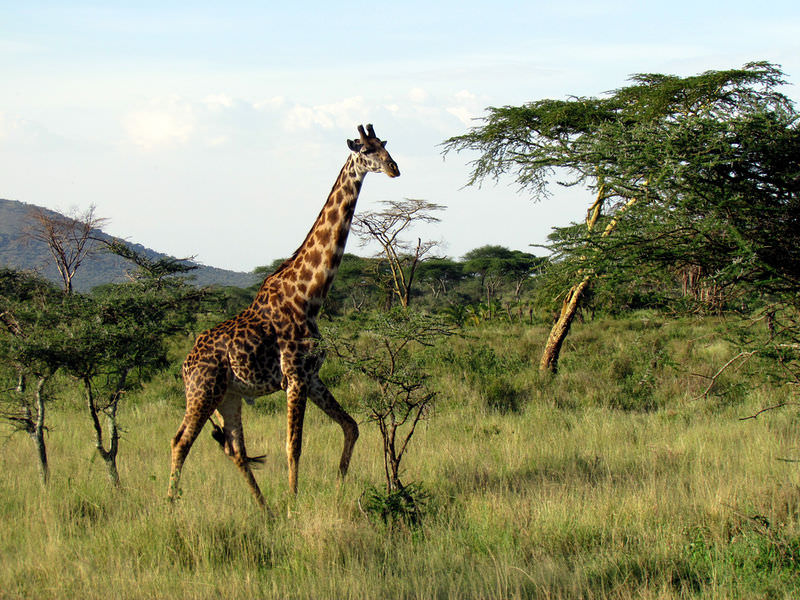
Which mammalian trait evolved first? What was the first mammal like? When did the earliest mammal live?
Detailed answers to these questions are still in dispute, though it is probably safe to say the earliest mammals were not like this giraffe. Obviously, the giraffe has some specialized traits.
Major Events in Mammalian Evolution
Scientists do generally agree on the major events in the evolution of mammals. These are summarized in Table below. Refer back to the table as you read about the events in this concept. *mya = millions of years ago
| Era | Period | Epoch | Major Events | Start (mya)* |
|---|---|---|---|---|
| Cenozoic | Neogene | Holocene | Rise of human civilization; spread and dominance of modern humans | 0.01 |
| - | - | Pleistocene | Spread and then extinction of many large mammals; appearance of modern humans | 1.8 |
| - | - | Pliocene | Appearance of many existing genera of mammals, including the genus Homo | 5.3 |
| - | - | Miocene | Appearance of remaining modern mammal families; diversification of horses and mastodons; first apes | 23.0 |
| - | Paleogene | Oligocene | Rapid evolution and diversification of placental mammals | 33.9 |
| - | - | Eocene | Appearance of several modern mammal families; diversification of primitive whales | 55.8 |
| - | - | Paleocene | Appearance of the first large mammals | 65.5 |
| Mesozoic | Cretaceous | - | Emergence of monotreme, marsupial, and placental mammals; possible first appearance of four clades (superorders) of placental mammals (Afrotheria, Xenarthra, Laurasiatheria, Supraprimates) | 145.5 |
| - | Jurassic | - | Spread of mammals, which remain small in size | 199.6 |
| - | Triassic | - | Evolution of cynodonts to become smaller and more mammal-like; appearance of the first mammals | 251.0 |
| Paleozoic | Permian | - | Evolution and spread of synapsids (pelycosaurs and therapsids) | 299.0 |
| - | Carboniferous | - | Appearance of amniotes, the first fully terrestrial vertebrates | 359.0 |
Mammalian Ancestors
Ancestors of mammals evolved close to 300 million years ago. They were amniotes called synapsids. Figure below shows how modern mammals evolved from synapsids. The stages of evolution from synapsids to mammals are described below.
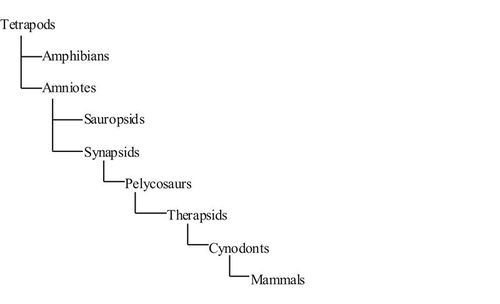 Phylogeny of Mammalian Evolution. This diagram represents the evolution of mammals.
Phylogeny of Mammalian Evolution. This diagram represents the evolution of mammals.Pelycosaurs
Synapsids called pelycosaurs became the most common land vertebrates during the first half of the Permian Period. A pelycosaur genus called Dimetrodon is shown in Figure below. Dimetrodon had sprawling legs and walked like a lizard. It also had a fairly small brain. However, it had started to develop some of the traits of mammals. For example, it had teeth of different types.
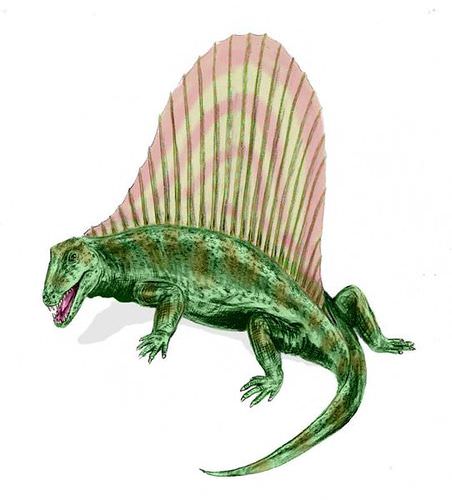 Pelycosaur Synapsid: Dimetrodon. Dimetrodon was a pelycosaur. It lived about 275 million years ago.
Pelycosaur Synapsid: Dimetrodon. Dimetrodon was a pelycosaur. It lived about 275 million years ago.Therapsids
Some pelycosaurs gave rise to a group of animals called therapsids. The earliest therapsids lived about 260 million years ago. At first, the therapsids looked a lot like Dimetrodon. But after a while, they could easily be mistaken for mammals. They evolved a number of mammalian traits, such as legs positioned under the body instead of along the sides. Therapsids became the most common and diverse land vertebrates during the second half of the Permian Period.
The Permian Period ended about 250 million years ago with a mass extinction. Most therapsids went extinct. Their niches were taken over by sauropsids. These were the amniotes that evolved into dinosaurs, reptiles, and birds. Not all therapsids went extinct, however. The few that remained no longer had to compete with many other therapsids. Some of them eventually evolved into mammals.
Cynodonts
The surviving therapsids were small animals. Some of the most successful were the cynodonts (see Figure below). They flourished worldwide during the first half of the Triassic Period. Some of them ate insects and were nocturnal, or active at night. Being nocturnal may have helped save them from extinction. Why? A nocturnal niche was one of the few niches that dinosaurs did not take over in the Triassic Period.
Cynodonts became more mammal-like as they continued to evolve. Some of their mammalian traits may have been adaptations to their nocturnal niche. For example:
- The ability to regulate body temperature might have been selected for because it would allow nocturnal animals to remain active in the cool of the night.
- A good sense of hearing might have been selected for because it would be more useful than good vision when hunting in the dark.
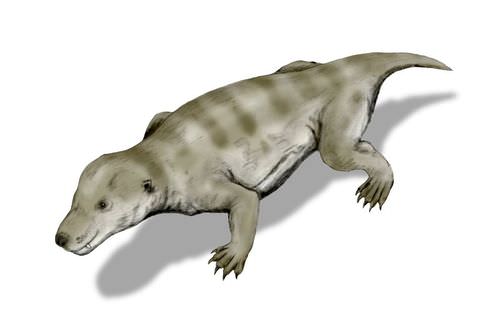 Probable Mammalian Ancestor: Cynodont. Cynodonts were mammal-like therapsids. They may have been ancestral to mammals. They were about the size of a rat.
Probable Mammalian Ancestor: Cynodont. Cynodonts were mammal-like therapsids. They may have been ancestral to mammals. They were about the size of a rat.By the end of the Triassic Period, cynodonts had become even smaller in size. They also had evolved many mammalian traits. For example, they had
- Four different types of teeth
- A relatively large brain
- Three tiny bones in the middle ear
- A diaphragm for breathing
- Endothermy
- Lactation
- Hair
Cynodonts probably gave rise to mammals about 200 million years ago. However, they are not considered to be mammals themselves. In fact, competition with early mammals may have led to their extinction. They went extinct sometime during the Jurassic or Cretaceous Period.
Summary
- Amniotes called synapsids were the ancestors of mammals.
- Synapsids named pelycosaurs had some of the traits of mammals by 275 million years ago.
- Some synapsids evolved into therapsids, which became widespread during the Permian Period.
- The few therapsids that survived the Triassic takeover were small, arboreal insect eaters. They were also nocturnal. Being active at night may explain why they survived and evolved still more mammalian traits.
Review
- What were the synapsids? When were they most widespread?
- Identify the therapsids. How were they related to mammals?
- Describe cynodonts. What is their place in the evolution of mammals?
- Describe mammalian traits found in cynodonts.
| Image | Reference | Attributions |
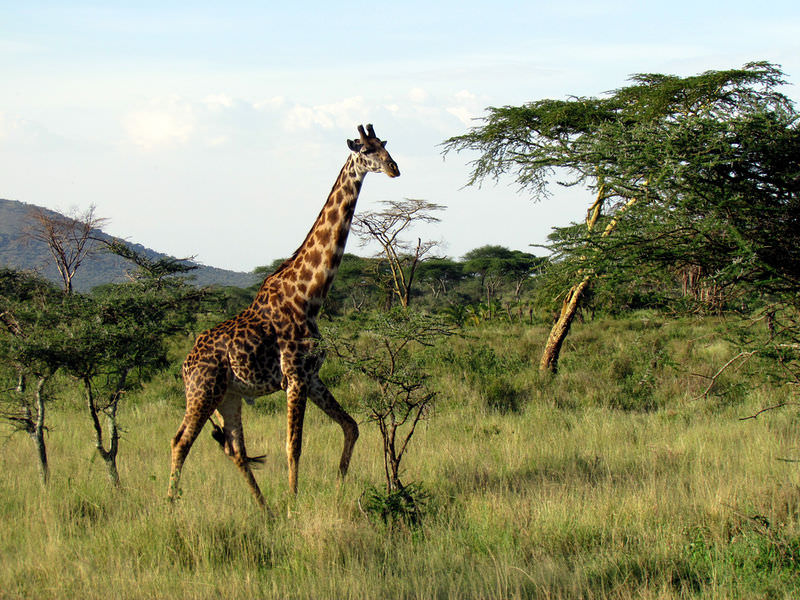 |
[Figure 1] | License: CC BY-NC |
 |
[Figure 2] | Credit: CK-12 Foundation Source: CK-12 Foundation License: CC BY-NC 3.0 |
 |
[Figure 3] | Credit: Nobu Tamura Source: commons.wikimedia.org/wiki/File:Dimetrodon_BW.jpg License: CC BY 2.5 |
 |
[Figure 4] | Credit: Nobu Tamura Source: commons.wikimedia.org/wiki/File:Steropodon_BW.jpg License: CC BY 3.0 |

